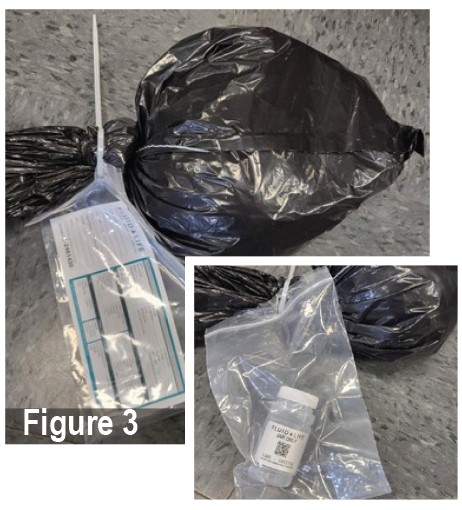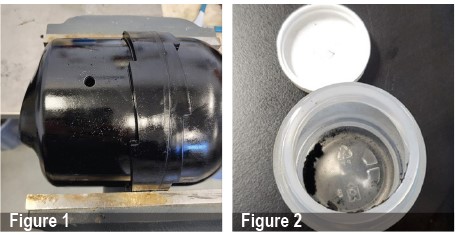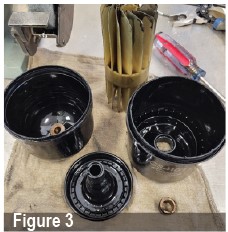Used Oil Filter Sampling
Centrifuge filters use a spinning rotor to collect sludge and return clean oil back to the sump. Following these guidelines will ensure samples arrive intact and uncontaminated, and will allow the most accurate results. Follow appropriate safety training and procedures and wear the correct PPE.
For Sealed Disposable Centrifuge Filters
- Allow the rotor to drain off free oil.
- Package the rotor/filter element in a primary container such as a strong zip lock bag, drum liner or garbage bag. Tie off the bag with minimal air pockets. See Figure 1.
- Package the primary container in secondary containment such as a second garbage bag or pail. Zip lock bags are not recommended for secondary containment. A shop towel or spill pad can be added. Do not add loose absorbent as it may contaminate the filter. Ensure secondary containment is tied off or sealed.
- Provide relevant sample information using the barcode on an empty sample jar and the mobile app or using a sample card. See Figure 2.
- The jar or card must be physically attached to the OUTSIDE of the secondary container on the clean side and protected from oil and contamination inside a black outer jar or a zip lock bag. This is to prevent any leaking oil from damaging the jar or card and making it unreadable. The jar or card can be zip-tied to the secondary container or taped securely. See Figure 3. A physical connection between the filter and the sample information is necessary to ensure the Filter Analysis results are applied to the correct unit and sample location.


For Disposable Drop-in Centrifuge Filters
For larger and thicker CS41048 and similar style filters.
- Ensure filter drained and free of solvent before proceeding. Note: The filter assembly will become heavier as spinner material (a clay like sludge) accumulates in the filter.
- Safely secure filter in a vice or suitable clamp.
- Drill a hole in the side of the filter approximately 1/4” to 3/8” in diameter (8-12mm). See Figure 1.
- Using a clean screwdriver, plastic scoopula or other suitable tool, extract approximately 1g of spinner cake. Spinner cake is a hardened clay like sludgy build up along the outer circumference of the rotor.
- Additional holes can be drilled to collect additional samples as required. Take care to minimize the amount of plastic material collected.
- Place spinner cake into a clean labeled sample jar. See Figure 2. Label the jar with appropriate identification.

For Smaller CS41011 and Similar Filters
These filters have a smaller diameter and thinner shell. The larger and thicker CS41018 and similar assemblies should not be sampled using this method. Their shell is too thick and strong.
- Ensure filter is drained and free of solvent before proceeding. Note: The filter assembly will become heavier as spinner material (a clay like sludge) accumulates in the filter.
- Secure filter in a vice along the shorter circular diameter with the ridges in the vice. Wrap filter in shop rags or suitable material.
- Pressure can be applied to carefully crack the assembly open and separate the upper and lower sections. It should not take significant force. See Figure 3.
- Sub-sample material into a clean labeled sample jar. See Figure 2 above.
- If significant material is not present the oil and sludge accumulated in the assembly can be poured into a clean labeled sample jar.

Filter Sampling Kits
Filter sampling kits (part number 100640) are available at no charge when sending a filter in for SEM Analysis. Kits include the following items:
- Two large heavy-duty plastic bags (primary and secondary containment)
- Clear zip lock bag with Sample Card
- Zip tie
- Sample collection instructions
Do’s and Don’ts
- Avoid packing the filter in a box without primary and secondary packaging.
- Avoid putting sample information in the same container as the filter. The filter may leak oil and make the information unreadable.
- Do allow time for the filter to drain excess oil.
- Do ensure sample information is securely fastened to the filter packaging and there is a physical connection.
- Do use secondary containment.

